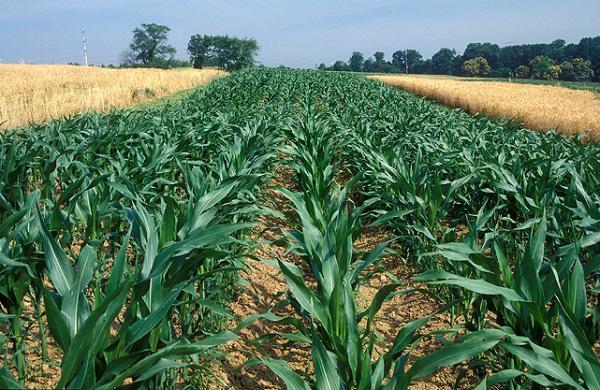
Agricultural News
GM Crops Help Ensure Global Food Security Through Higher Crop Yields
Thu, 07 May 2015 11:35:00 CDT
 Farmers around the world who use seeds improved with biotechnology continue to benefit economically while improving the environmental sustainability of their farming operations according to an updated global impacts study.
Farmers around the world who use seeds improved with biotechnology continue to benefit economically while improving the environmental sustainability of their farming operations according to an updated global impacts study.
The economic benefits for farmers who use genetically modified (GM) seeds amounted to an average of more than $122/hectare in 2013, according to the report "GM Crops: Global Socio-Economic and Environmental Impacts 1996-2013" released today by PG Economics.
"In 2013, the 18th year of widespread adoption of crops using biotechnology innovations, the technology has continued to provide more productive agriculture, higher incomes to farmers and a better environment for citizens. A majority of these benefits continue to go to farmers and rural communities in developing countries," said Graham Brookes, director of PG Economics, co-author of the report.
Matt O'Mara, acting executive vice president for food and agriculture for the Biotechnology Industry Organization (BIO), stated the report's findings regarding biotechnology's contributions to the environment are especially significant.
"Crop biotechnology has reduced pesticide use by almost 550 million kilograms. This means farmers are spending less time on the tractor, burning less fossil fuels which ultimately reduces carbon dioxide emissions," says O'Mara. "In addition, the switch to no-till cropping systems by farmers growing herbicide-tolerant crops have enhanced soil quality and have enabled farmers to switch to more benign herbicides to help control weeds."
"The PG Economics annual global impacts report quantifies the impact of agricultural biotechnology on the environment and on farmer incomes since biotech's commercialization in 1996. Among the key findings:
-- Between 1996 and 2013, crop biotechnology was responsible for additional global production of 138 million tonnes of soybeans and 274 million tonnes of corn. The technology has also contributed an extra 21.7 million tonnes of cotton lint and 8 million tonnes of canola;
-- GM crops are allowing farmers to grow more without using additional land. If crop biotechnology had not been available to the (18 million) farmers using the technology in 2013, maintaining global production levels at the 2013 levels would have required additional plantings of 5.8 million ha of soybeans, 8.3 million ha of corn, 3.5 million ha of cotton and 0.5 million ha of canola. This total area requirement is equivalent to 11% of the arable land in the US, or 29% of the arable land in Brazil or 32% of the cereal area in the EU (28);
-- The insect resistant (IR) technology used in cotton and corn has consistently delivered yield gains from reduced pest damage. The average yield gains over the 1996-2013 period across all users of this technology has been +11.7% for insect resistant corn and +17% for insect resistant cotton. 2013 also saw the first IR soybeans grown commercially in South America, where farmers have seen an average of +10% yield improvements;
-- The herbicide tolerant (HT) technology used in soybeans and canola has also contributed to increased production in some countries; by helping farmers in Argentina grow a crop of soybeans after wheat in the same growing season, through higher yields and improved weed control;
-- Crop biotechnology helps farmers earn reasonable incomes for their work. The net economic benefit at the farm level in 2013 was $20.5 billion, equal to an average increase in income of $122/hectare. For the 18 year period (1996-2013), the global farm income gain has been $133.5 billion;
-- The total farm income gain of $133.5 billion was divided equally between farmers in developing and developed countries;
-- The highest yield gains were obtained by farmers in developing countries, many of which are resource-poor and farm small plots of land;
-- Crop biotechnology continues to be a good investment for farmers around the world. The cost farmers paid for accessing crop biotechnology in 2013 ($6.8 billion payable to the seed supply chain) was equal to 25% of the total gains (a total of $27.3 billion inclusive of the $20.5 billion income gains). Globally, farmers received an average of $4.04 for each dollar invested in GM crop seeds;
-- Farmers in developing countries received $4.22 for each dollar invested in GM crop seeds in 2013 (the cost being equal to 24% of total technology gains), while farmers in developed countries received $3.88 for each dollar invested in GM crop seed (the cost being equal to 26% of the total technology gains). The higher share of total technology gains realized by farmers in developing countries relative to farmers in developed countries mainly reflects weaker provision and enforcement of intellectual property rights coupled with higher average levels of benefits in developing countries;
-- Crop biotechnology has contributed to significantly reducing the release of greenhouse gas emissions from agricultural practices. This results from less fuel use and additional soil carbon storage from reduced tillage with GM crops. In 2013, this was equivalent to removing 28 billion kg of carbon dioxide from the atmosphere or equal to removing 12.4 million cars from the road for one year;
-- Crop biotechnology has reduced pesticide spraying (1996-2013) by 550 million kg (-8.6%). This is equal to the total amount of pesticide active ingredient applied to arable crops in the EU 27 for two crop years. As a result, this has decreased the environmental impact associated with herbicide and insecticide use on the area planted to biotech crops by 19%.
**To download the full report, "GM Crops: Global Socio-Economic and Environmental Impacts 1996-2012", CLICK HERE.
WebReadyTM Powered by WireReady® NSI
Top Agricultural News
More Headlines...




















